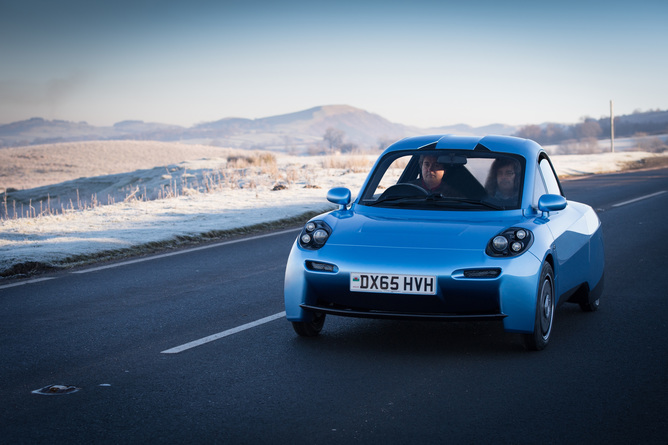The prototype of a car powered by a hydrogen fuel cell was unveiled this month by the Welsh company Riversimple. The company has named its vehicle named “Rasa” after the Latin phrase tabula rasa, which means: clean slate.
This is not the first fuel cell car – we already have Toyota’s Mirai, while Honda made its FCX Clarity fuel cell car available to carefully selected clients for lease some years ago and is due to unveil a successor this year. But the Rasa is very different – while Japanese and Korean companies tend to follow the North American design principle of simply adding the fuel cell technology to a traditional vehicle template, Riversimple has, in many respects, gone back to the beginning; hence the name: clean slate.
And where better to develop such a car than in Wales, which has traditionally supported low-carbon vehicle technologies – and where Sir William Groves first invented the hydrogen fuel cell?
Riversimple’s founder and chief engineer, Hugo Spowers, has long argued that the technology in previous fuel cell vehicles was unnecessarily complex and expensive. This has created an impression in the market – and the wider industry – that hydrogen fuel cell technology is inherently expensive. Spowers says that, scaled down, a fuel cell system doesn’t need to be particularly costly – but a small fuel cell powertrain (the components, including the engine, that essentially make the car go) can only power a light car.

Sleek and simple – but can the Rasa compete? Riversimple
As a result, Riversimple has developed a car not unlike the “hypercar” concept developed in the 1990s by Rocky Mountains Institute founder Amory Lovins. Lovins argued that cars needed to shed half their weight, but that once you started aiming for this you would find that all sorts of onboard systems could be downsized as well, or removed altogether, leaving you effectively with a vehicle only a quarter of the weight of a conventional car – what he called a “factor four” improvement.
The Riversimple Rasa weighs in at only 580kg, compared with the original Lotus Elise at 770kg, or the first generation Smart at 752kg. This is achieved by intensive use of carbon fibre and aluminium and, like the Elise and Smart, the Rasa is also a two-seater. Though once regarded as an expensive technology – which when optimised for aerospace or Formula 1 applications it can be – much work, particularly in the UK in recent years, has shown that, for ordinary road cars, cheaper methods of using this material are possible.
Yet these advanced features of the car overshadow the equally interesting fact that it is accompanied by a new automotive business model: the car is not for sale, but can be leased as part of a transport provision package. While leasing is also used by Toyota and Honda as a way of marketing their fuel cell cars, in this case as the car ages it is gradually leased to less demanding customers at a lower cost. Eventually the vehicle will go back to Riversimple for refurbishment and re-leasing. The car therefore becomes the means and not the end for running the business.
The facilities for assembling the car and dealing with it over its lifetime follow a dispersed manufacturing model of small, local facilities, rather than the large, centralised factories of conventional car manufacturers. This is made possible by the technologies used, particularly the body/chassis system, which operatesat much lower level of economies of scale than conventional steel body technology – meaning that the more are produced, the cheaper it gets to make each one.
However, some issues remain. Despite there being are a number of hydrogen (H2) production facilities in the UK –- three along the M4 corridor in south Wales alone –- it is not readily available to consumers. In this respect, the Rasa’s launch is well timed, as H2 infrastructure will also be needed by the Toyota Mirai and its competitors. In the meantime, Riversimple will put hydrogen filling points near the 20 or so trial users of this first generation of Rasas.

The Rasa’s stripped down interior doesn’t compromise on style. Riversimple
Questions also remain over the production of hydrogen. Unlike petrol or diesel, it is not a fuel, but an energy carrier and has to be produced from hydrocarbons, or by splitting water. The latter, in particular, can be very energy intensive, while the former often involves using fossil fuels, the source of most current hydrogen production.
At the same time, experiments are taking place – in Germany, for example – using hydrogen to store excess electricity generated from renewable sources. This may work if such technologies are adopted more widely, although current UK energy policy seems to prefer a 20th-century approach rather than embracing such new technologies.
Some may also question whether we still need fuel cell electric cars with the advent of battery-electric cars. Spowers sees a role for both and deliberately positions the Rasa as a local vehicle for commuting, shopping, social visits and the like. This way, like the many fuel cell buses in use around the world, it never strays far from its fuelling point. This means that unlike an EV in similar use it would only need to refuel once a week or so, rather than every day. The 300 mile range of the Rasa beats the Nissan Leaf, a battery EV targeted at a similar market, which can travel up to 155 miles between charges.
Overall the Rasa certainly does wipe the slate clean for Britain’s sustainable car industry. Whether it will prove to be the best option will no doubt be apparent after the 12-month trial due to start later this year.
 Paul Nieuwenhuis does not work for, consult, own shares in or receive funding from any company or organization that would benefit from this article, and has disclosed no relevant affiliations beyond the academic appointment above.
Paul Nieuwenhuis does not work for, consult, own shares in or receive funding from any company or organization that would benefit from this article, and has disclosed no relevant affiliations beyond the academic appointment above.
Paul Nieuwenhuis, Senior Lecturer and Co-Director, Electric Vehicle Centre of Excellence (EVCE), Cardiff University
This article was originally published on The Conversation. Read the original article.




 Morgan Stanley Boosts Nvidia and Broadcom Targets as AI Demand Surges
Morgan Stanley Boosts Nvidia and Broadcom Targets as AI Demand Surges  TSMC Accuses Former Executive of Leaking Trade Secrets as Taiwan Prosecutors Launch Investigation
TSMC Accuses Former Executive of Leaking Trade Secrets as Taiwan Prosecutors Launch Investigation  Australia Moves Forward With Teen Social Media Ban as Platforms Begin Lockouts
Australia Moves Forward With Teen Social Media Ban as Platforms Begin Lockouts  Wikipedia Pushes for AI Licensing Deals as Jimmy Wales Calls for Fair Compensation
Wikipedia Pushes for AI Licensing Deals as Jimmy Wales Calls for Fair Compensation  EU Prepares Antitrust Probe Into Meta’s AI Integration on WhatsApp
EU Prepares Antitrust Probe Into Meta’s AI Integration on WhatsApp  Nexperia Urges China Division to Resume Chip Production as Supply Risks Mount
Nexperia Urges China Division to Resume Chip Production as Supply Risks Mount  Coupang Apologizes After Massive Data Breach Affecting 33.7 Million Users
Coupang Apologizes After Massive Data Breach Affecting 33.7 Million Users  Apple Appoints Amar Subramanya as New Vice President of AI Amid Push to Accelerate Innovation
Apple Appoints Amar Subramanya as New Vice President of AI Amid Push to Accelerate Innovation  Vietnam’s Growing Use of Chinese 5G Technology Raises Western Concerns
Vietnam’s Growing Use of Chinese 5G Technology Raises Western Concerns  Samsung Launches Galaxy Z TriFold to Elevate Its Position in the Foldable Smartphone Market
Samsung Launches Galaxy Z TriFold to Elevate Its Position in the Foldable Smartphone Market  Senate Sets December 8 Vote on Trump’s NASA Nominee Jared Isaacman
Senate Sets December 8 Vote on Trump’s NASA Nominee Jared Isaacman  Trump Administration to Secure Equity Stake in Pat Gelsinger’s XLight Startup
Trump Administration to Secure Equity Stake in Pat Gelsinger’s XLight Startup  Microchip Technology Boosts Q3 Outlook on Strong Bookings Momentum
Microchip Technology Boosts Q3 Outlook on Strong Bookings Momentum  Quantum Systems Projects Revenue Surge as It Eyes IPO or Private Sale
Quantum Systems Projects Revenue Surge as It Eyes IPO or Private Sale  Australia Releases New National AI Plan, Opts for Existing Laws to Manage Risks
Australia Releases New National AI Plan, Opts for Existing Laws to Manage Risks  Apple Leads Singles’ Day Smartphone Sales as iPhone 17 Demand Surges
Apple Leads Singles’ Day Smartphone Sales as iPhone 17 Demand Surges  YouTube Agrees to Follow Australia’s New Under-16 Social Media Ban
YouTube Agrees to Follow Australia’s New Under-16 Social Media Ban 





























